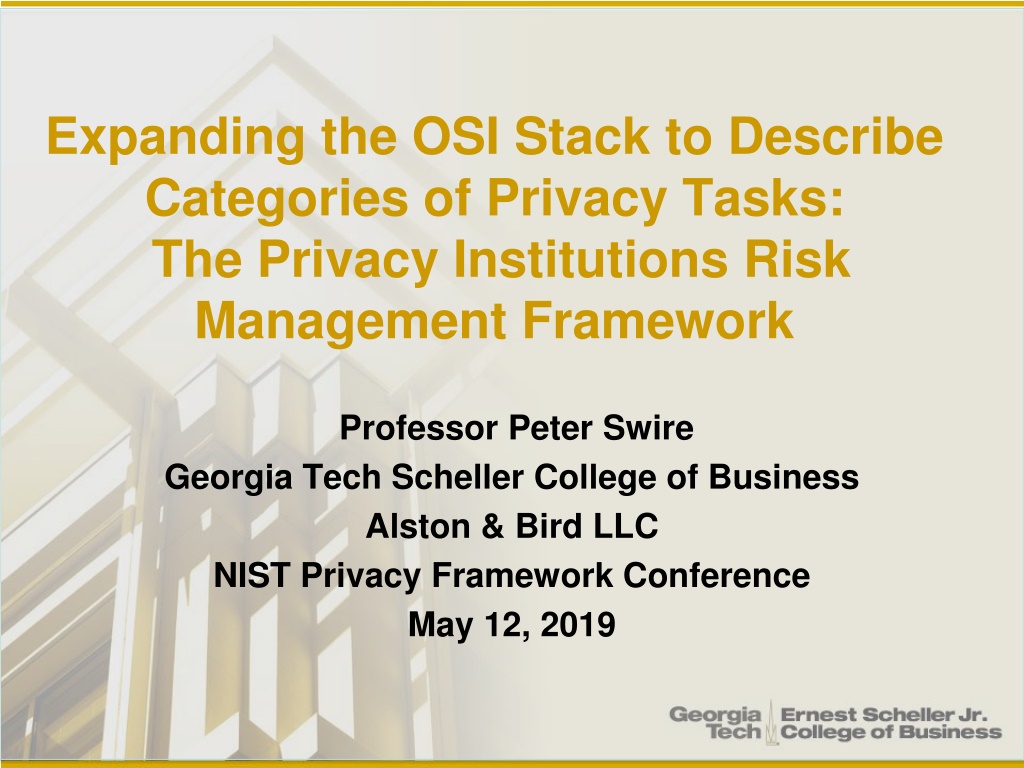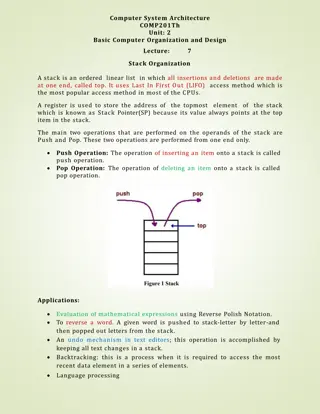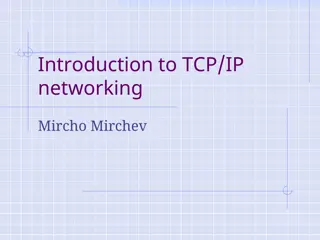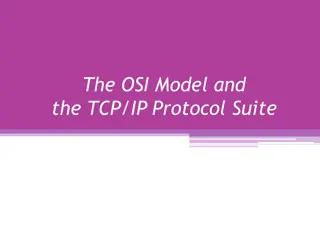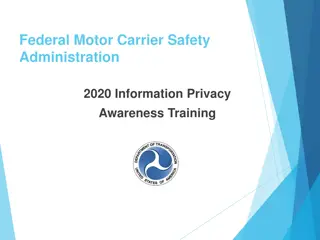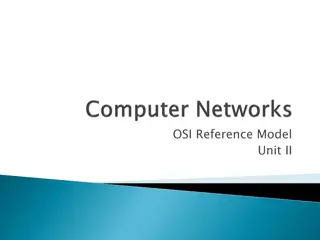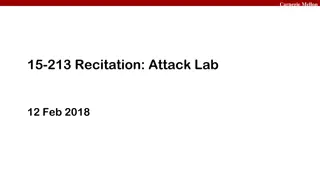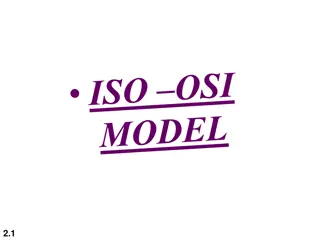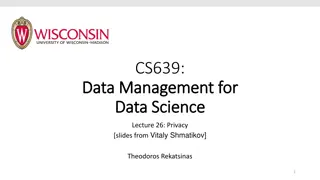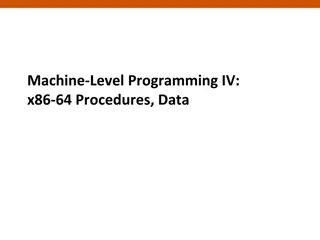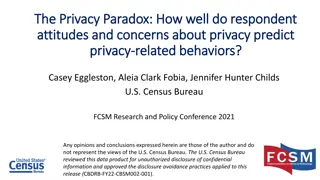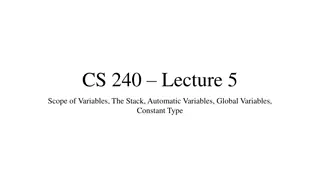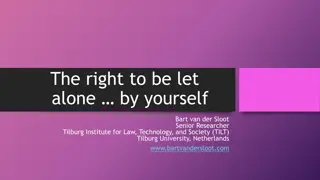Expanding the OSI Stack for Privacy Risk Management
Explore the categorization of privacy risks within enterprises beyond internal practices, contractual obligations, and regulatory frameworks. The presentation delves into the development of a Privacy Institutions Risk Management framework proposed by Professor Peter Swire at Georgia Tech, Scheller College of Business, to address the evolving landscape of privacy discussions.
Download Presentation

Please find below an Image/Link to download the presentation.
The content on the website is provided AS IS for your information and personal use only. It may not be sold, licensed, or shared on other websites without obtaining consent from the author.If you encounter any issues during the download, it is possible that the publisher has removed the file from their server.
You are allowed to download the files provided on this website for personal or commercial use, subject to the condition that they are used lawfully. All files are the property of their respective owners.
The content on the website is provided AS IS for your information and personal use only. It may not be sold, licensed, or shared on other websites without obtaining consent from the author.
E N D
Presentation Transcript
Expanding the OSI Stack to Describe Categories of Privacy Tasks: The Privacy Institutions Risk Management Framework Professor Peter Swire Georgia Tech Scheller College of Business Alston & Bird LLC NIST Privacy Framework Conference May 12, 2019
Introduction Warm welcome to this conference, to consider the draft NIST Privacy Framework: An Enterprise Risk Management Tool
Introduction One observation comparing NIST Cybersecurity and Privacy Frameworks: Cybersecurity Framework expanded the scope of discussions about cybersecurity Previous discussions focused on the technical aspects of cybersecurity NIST Framework adds organizational & management aspects Privacy Framework focuses on part of long-standing discussions about privacy Important to define scope of Privacy Framework, and locate within pre-existing privacy discussions
Overview of this Presentation Build on published research about the non-code aspects of cybersecurity Apply that framework to privacy risk management Categorize privacy risks to an enterprise beyond the internal and contractual practices of the organization Propose an intellectual structure to locate the scope of the draft in the broader set of privacy discussions, such as self- regulation, national laws, and rules for cross-border data flows Propose a Privacy Institutions Risk Management (PIRM) Framework
Theme of CACM Article: Growth in Non-Code Cybersecurity Real cybersecurity today devotes enormous effort to non- code vulnerabilities and responses. The Cybersecurity Workforce Framework of the National Initiative for Cybersecurity Education lists 33 specialty areas for cybersecurity jobs. Ten of the specialty areas primarily involve code, but more than half primarily involve non-code work (15 areas, in my estimate) or are mixed (eight areas, per my assessment). CACM article seeks to categorize the non-code aspects of cybersecurity Expand the OSI stack to new layers 8, 9, 10 Define for each layer the problems, disciplines, and team membership
Seven Layers of the OSI Stack In my experience, these seven layers are well known to knowledgeable computer people who work on cybersecurity. Intuitively, they also know that cyber-attacks can happen at any of these 7 levels.
Layers 8, 9, and 10: Natural Language Layer 10 International Natural language Natural language Diplomacy Layer 9 Governmental Law Layer 8 Organizational Natural Contracts language Computer Code Layers 1-7 OSI stack Various protocols
Examples from Cybersecurity GT MGMT/CoC/PubPol 4726/6726 Information Security Strategies and Policy Required for Masters in Cybersecurity How do all the pieces of this course fit together? Tasks: Layer 8: Corporate cybersecurity policies and governance e.g., draft ransomware policy for a hospital group Layer 9: Government laws/regulations e.g., proposed state legislation to govern IoT cybersecurity Layer 10: Nation state and international e.g., draft National Security Council memo on cyberthreats from Russia and policy options to respond For each, what skill set needed on the enterprise team, to effectively manage risks? Skills needed beyond areas where computer scientists are comfortable
Create a 3x3 Matrix: Institutional Sources of Governance of Risk Horizontal layers Layer 8: organizational Layer 9: government Layer 10: international Vertical columns Column A: actions within an organization or nation Column B: relations with other actors Column C: other limits from that layer Layer 8: limits on private sector from private sector Layer 9: limits on government from government Layer 10: limits on nation from other nations
Layer 8: Privacy within Organizations: Contracts Within the Organization Relations with Other Actors Other Limits on Private Sector Examples of privacy law and policy Roles, such as CPO, lawyers and privacy engineers DPIAs/PIAs & other internal policies Training Systems for access and other data subject rights Users precautions Vendor & other contracts & management More broadly, rules on data dissemination, including to researchers Breach insurance DAA auto, and other self-regulatory standards Technical standards such as W3C and IETF For each, what skill set on the team?
Layer 9: Government Layer: Law Within the Organization Relations with Other Actors Limits on Government Examples of privacy law and policy GDPR, HIPAA, GLBA, and other privacy laws (100+ countries) Data breach laws spreading Rules limiting strong encryption De-identification rules (fewer limits where not PII/personal data) Constitutional and statutory limits on what the state can do, such as 4th Amendment, ECPA, FISA, or other illegal surveillance Processor/business associate rules Data broker/public record rules Rules on data acquisition & dissemination For each, what skill set on the team?
Layer 10: International Layer: Diplomacy Within the Nation Relations with Other Nations Other Limits on Nations Examples of privacy law and policy Non-binding international approaches, such as OECD Privacy Guidelines Formal agreements, such as EU/US Privacy Shield or EU/Japan adequacy Cooperation with other nations, such as coordinated privacy enforcement Possible supra- national rules, such as by UN European Convention on Human Rights (Strasbourg Court) Council of Europe Convention 108 and Budapest Convention Limits on cross- border transfer, such as prohibit export to nations that lack adequate protections Data localization requirements, to protect citizens or enable law enforcement access For each, what skill set on the team?
Where do Users fit? Focus of 3x3 matrix on managing privacy risks for organizations, governments, and internationally A user is not an organization, government or international actor I suggest users are part of Layer 8 Private sector actors range from individual users/sole proprietorship to modest size to large organizations EU law individuals retain privacy rights when acting in business capacity Users lack an IT department, a general counsel, and face lots of risks 8A: Within the household how individual/family manages privacy risks 8B: Relations with other actors Terms of service, identity theft insurance, hire Geek Squad User protection is a big concern at 9A (government regulation of business), such as GDPR, HIPAA
Implications for Managing Privacy Risk Computer scientists/engineers are used to thinking about layers 1 to 7 CACM: Pedagogic Cybersecurity Framework (PCF) Today: Privacy Institutions Risk Management Framework (PIRM Framework) (Suggestions for other title?) The expanded OSI stack helps privacy engineers and others: Spot the risks and mitigations for each part of layers 8 to 10 Define the skill sets needed for your team Enterprise draws on the relevant expertise in technology, organizational behavior, law, and international relations as needed
Research Agenda for Managing Privacy Risks Each cell in the 3x3 matrix has characteristic research questions 8B how to design (law/business) and implement (privacy engineering) contracts for data acquisition and dissemination? 8C and 9A law and political science questions of mix of markets, regulation, and self-regulation to protect privacy 10C role of supranational institutions (international relations)
Potential for the Privacy Curriculum Helps describe what topics are done in each course: Mostly corporate governance for CPOs (layer 8) Mostly design of state/national laws (layer 9) Mostly international relations, for global interoperability (layer 10) An overall curriculum could determine how full the coverage is of the 3x3 matrix
PIRM Framework and Possible Integration with NIST Privacy Framework NIST Framework: An EnterpriseRisk Management Tool Current draft focuses on 8A (compliance within an organization) and 8B (contracts with other organizations) Word search for Regulatory - legal/regulatory now a small part of Identify activities Privacy Institutions Risk Management Framework highlights ways that enterprise risk management intersects with a broader set of competencies and issues With steady stream of issues at layers 8C, 9, and 10 the enterprise team should have skill set to identify and respond to a wide range of privacy-related developments Example: current project for one company on how to respond to risk of cut-off of personal data from EU to U.S. under Schrems II case now at the European Court of Justice
Conclusion: Contributions of the 10-layer stack Privacy Institutions Risk Management Framework provides a parsimonious structure to organize the jumble of issues now crowding into privacy management, law, and policy For practitioners, students, and teachers, a way to keep the many issues straight Enterprise risks can happen at layers 8, 9, and 10, if the company has bad policies, the nation has bad laws, or the international community disrupts appropriate data flows Because so much of privacy discussion to date has been outside of 8A and 8B, intellectually important to find some way to place NIST draft into a more comprehensive intellectual framework The PIRM Framework is one candidate to put the current NIST draft into a broader, organizing approach to privacy risk management That would clarify what the NIST draft does, and does not, seek to do Thank you
